Go to All Blogs | Birding in Norfolk Blog | Our UK Office | Norfolk Birding Day Tours | UK Birding Tours
European Birding Tours | All our Birding Tours
Posted on 09 June 2021, updated on 19 June 2025
Andy Walker offers some thoughts on the common wetland and coastal birds of the UK in the third and final installment of our blog posts on the common birds of the UK.
As the UK is an island and located in the northwest of continental Europe, there is plentiful coastline (ranging from towering rocky cliffs to salt marshes, beaches, and dunes), and so coastal birds and seabirds feature heavily in the country’s bird life. The island is also crisscrossed by rivers and riddled with natural and man-made waterbodies (such as lakes, gravel pits, fresh marshes, wet meadows, reservoirs, etc.) and so loads of birds reliant on water can be found. Seasonally, many waterbirds leave continental Europe, especially when waterbodies start to freeze over in winter. Due to the warming influence of the Gulf Stream. keeping the UK milder than mainland Europe. during the winter months, many of these birds seek refuge in the UK – which makes it a great time for birdwatching in the UK.
These habitats are hugely important to breeding birds (the UK has some amazing breeding seabird colonies – such as RSPB Bempton Cliffs in Yorkshire, England) and overwintering birds (as well as birds on spring or autumn passage migration). We will spend lots of time covering these habitats across our UK: England in Spring Birding Tour, UK: Highlands and Islands of Scotland Birding Tour and UK: England Fall Migration Special Birding Tour, as well as our Norfolk Day Tours, Suffolk Day Tours and Cornwall Day Tours.
Here we present a sample of some of the common wetland and coastal birds found across the UK. Most of these species also occur on several of our wide range of European birdwatching tours, giving you more opportunities to connect with these beautiful species. We hope you enjoy looking through these photos and hopefully learn a little bit about each species shown here.
Great Crested Grebe, Podiceps cristatus
A large and attractive waterbird found widely across the UK, particularly where there is deep water and large waterbodies. This is actually the largest and most familiar grebe in Europe. In summer plumage, they are unmistakable with gorgeous head plumes and on our spring and summer British bird tours we may get to enjoy pairs of these grebes undertaking their “penguin dance” – when the male and female raise their whole body upright out of the water breast to breast as they dance!
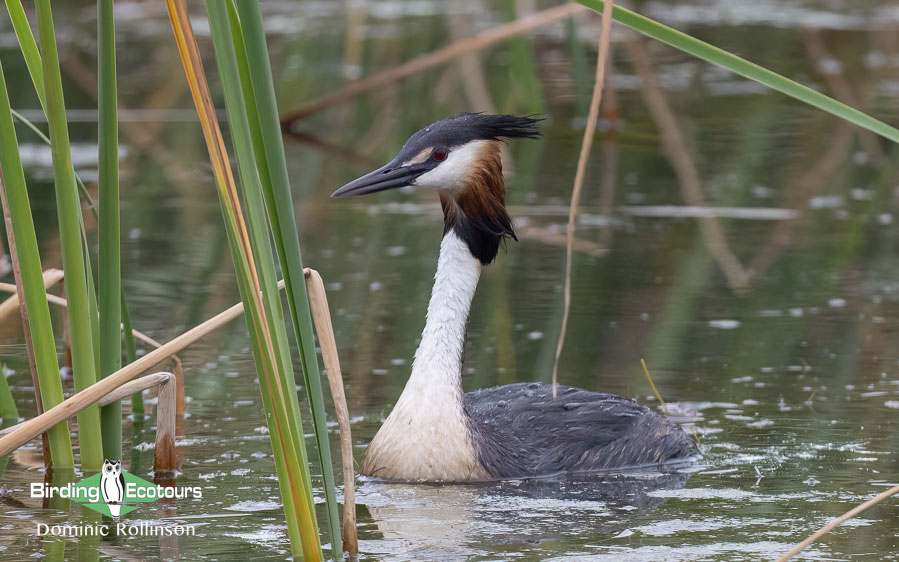
Great Crested Grebe on a nest.
Grey Heron, Ardea cinerea
A large and common heron found across the UK. They stand up to 40 inches (102 centimeters) tall and have a wingspan of up to 69 inches (175 centimeters) – very similar in size to Great Egret. It hunts by wading in deep water where it waits patiently for fish to swim into reach. They also hunt small mammals and birds. In addition to feeding in lakes and riverbanks it also makes use of sea-bays.

A Grey Heron waiting patiently for a meal to swim into reach.
Pied Avocet, Recurvirostra avosetta (UK Amber List: Birds of Conservation Concern 5)
Generally considered uncommon in the UK, but one of the strongholds for the species is in the county of Norfolk. Norfolk is an important stop on our winter and summer UK birding tours and our Norfolk birdwatching day trips, so we have a great chance of finding this gorgeous shorebird (wader) on these. Their black-and-white pattern with sweeping upcurved bill makes them unmistakable. We usually get fantastic close looks at this gorgeous shorebird and many other more localized species such as Spotted Redshank at the wonderful RSPB Titchwell Marsh.
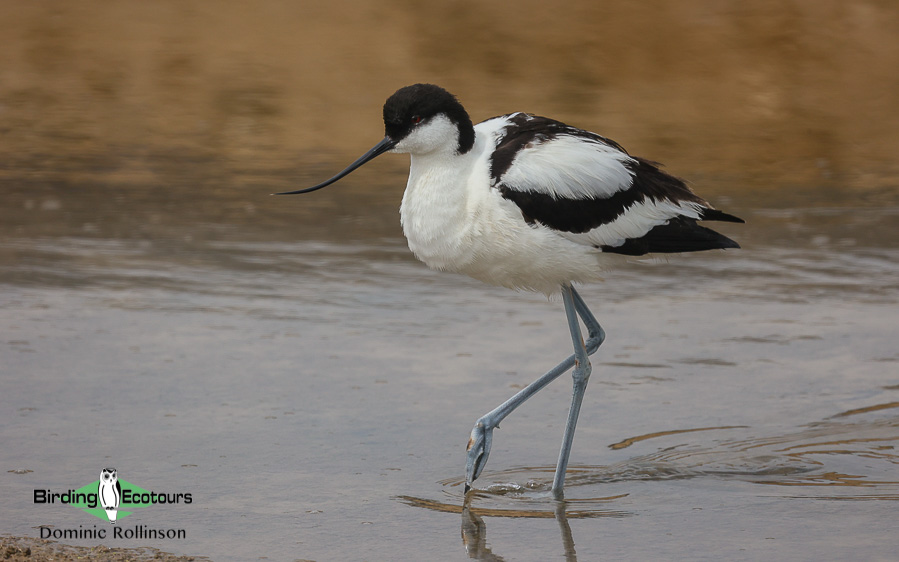
A profile of a Pied Avocet giving great views typical on our Norfolk birdwatching tours.
Eurasian Curlew, Numenius arquata (UK Red List: Birds of Conservation Concern 5)
The largest shorebird (wader) in Europe, unmistakable within the region with a long, evenly decurved bill. On our winter English bird tours, we find flocks of them at coastal wetland locations (such as at RSPB Snettisham) while during the summer breeding season tours, we will find them nesting at inland sites as their evocative calls ring out across upland heathland and farmland. However, this species is in long-term decline as a result of intensive agriculture, forestry, increasing generalist predator populations, and climate warming (BTO 2020), which is a real shame.
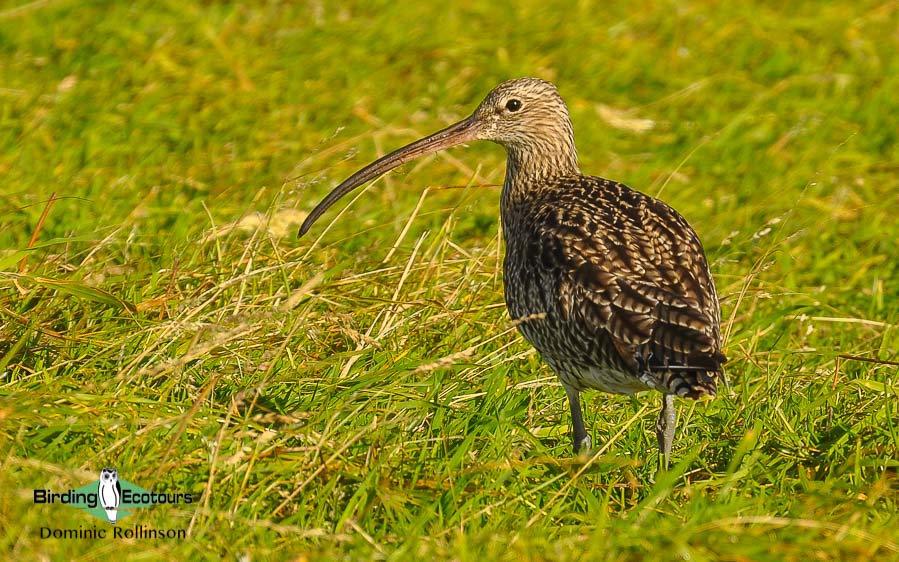
Just look at the bill on this Eurasian Curlew!
European Golden Plover, Pluvialis apricaria
Is one of the commonest shorebirds (waders) at coastal wetland sites across the British Isles during the non-breeding season, often mixing with Northern Lapwings and other shorebirds like Dunlin and Ruff. The Lower Derwent Valley National Nature Reserve near York in England (at Yorkshire Wildlife Trust Wheldrake Ings and North Duffield Carrs nature reserves) is an excellent site for these species. We will come across plenty of these pretty plovers as we bird in Norfolk, Lincolnshire, Yorkshire, and Northumberland where large numbers of these species spend the winter. On our summer UK birding tours, we will find these on their upland breeding grounds in Northern England and Scotland when they look absolutely spectacular.
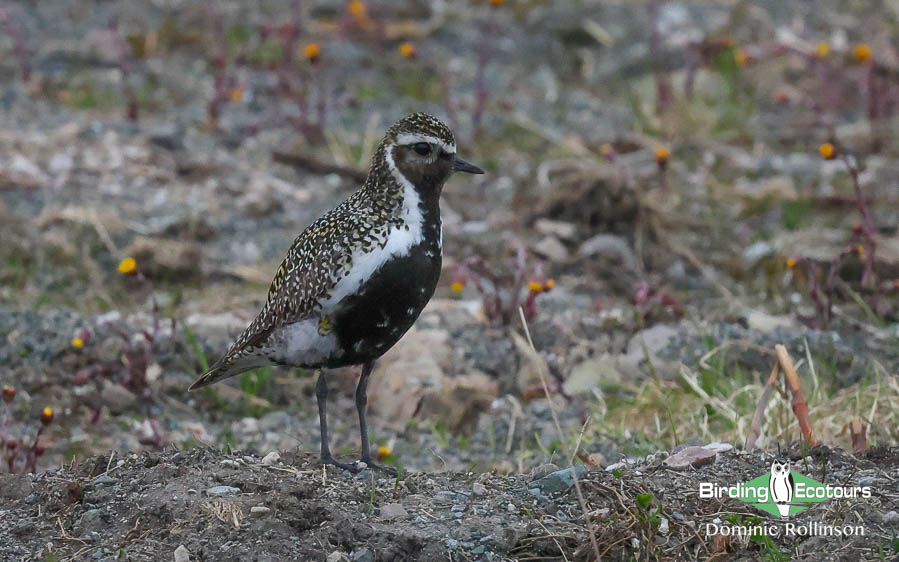
European Golden Plover are amazingly patterned in their breeding plumage.
Common Redshank, Tringa totanus (UK Amber List: Birds of Conservation Concern 5)
Another common shorebird (wader) in the UK (and in Europe as a whole) and one that will be enjoyed on all of our UK tours in wetland habitats. Their legs become extra red during the breeding season. They are usually quite shy and often very vocal.
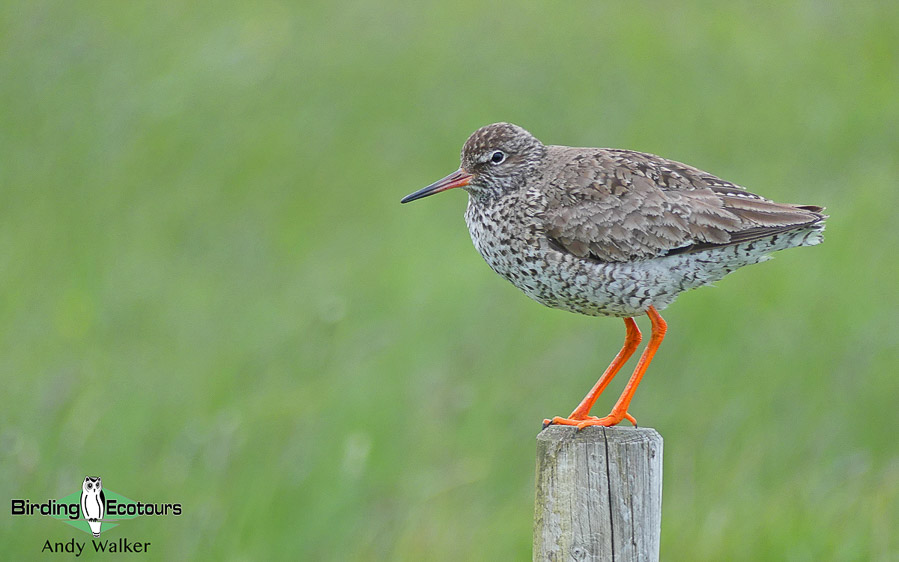
A breeding plumaged Common Redshank making use of a fence post song perch.
Black-tailed Godwit, Limosa limosa (UK Red List: Birds of Conservation Concern 5)
A gorgeous shorebird (wader) in breeding plumage. A common bird during the non-breeding season (when they do not quite look as spectacular as the bird shown below) but in certain areas of the UK they do breed. We stand a very good chance of seeing these birds during our birding in Norfolk and Yorkshire where they are often present year-round and fairly common where they do occur.
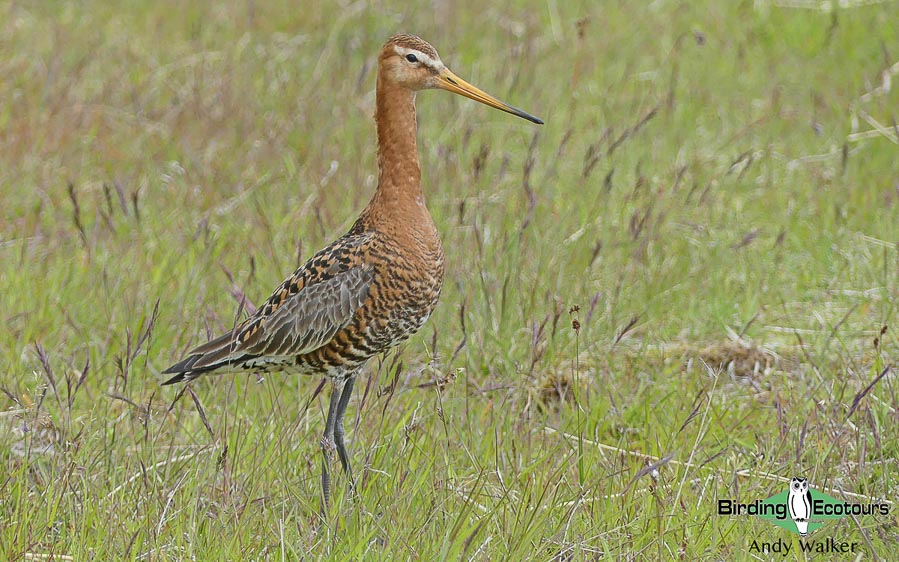
Black-tailed Godwit in breeding plumage is a fairly frequent sight, some birds breed in the UK and others develop breeding plumage before continuing to their breeding grounds in Iceland or northwest Europe.
Pink-footed Goose, Anser brachyrhynchus (UK Amber List: Birds of Conservation Concern 5)
An abundant winter visitor in the east of the UK when huge flocks can be found in Norfolk and Yorkshire. The sight and sound of these birds foraging and moving between feeding and roosting areas is one of the true winter spectacles in the UK. Our winter Norfolk day tours will connect with great views of this species, as will our UK-wide winter set departure tours.
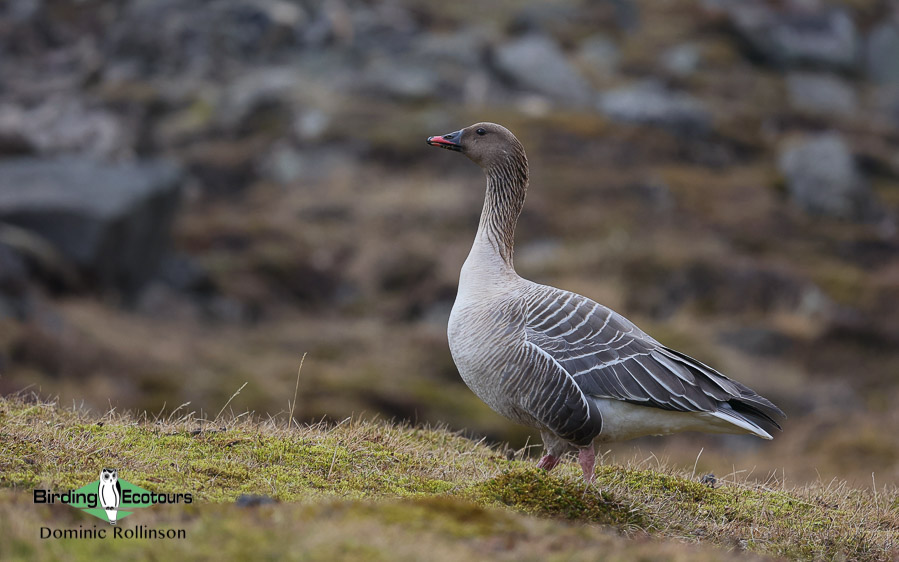
A lone Pink-footed Goose, an unusual sight, usually they are in vast flocks feeding in sugar beet or stubble fields.
Tufted Duck, Aythya fuligula
Pretty much overlooked by UK birders as they are so common across the country, but for visiting birders, they are one of the most-wanted species as they are so interesting-looking. Black and white with a bright yellow eye and long “hair tuft” on their rear crown, making them instantly recognizable. They are a diving duck so are usually found in deeper water than some common dabbling ducks like Eurasian Teal and Eurasian Wigeon.
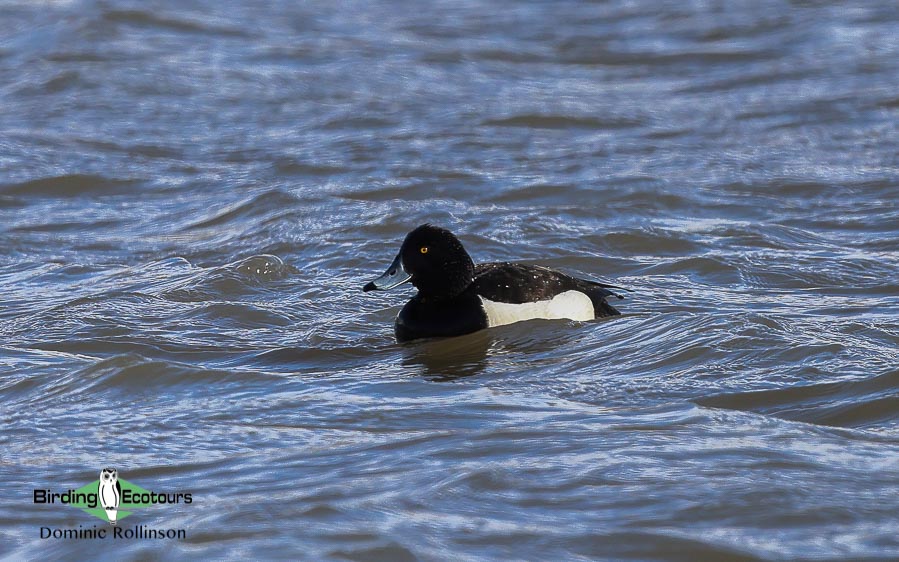
A male Tufted Duck showing the characteristic features, females are browner and with less of a tuft.
Eurasian Reed Warbler, Acrocephalus scirpaceus
A sub-Saharan African migrant common during the summer in Britain, but absent in the winter. They inhabit dense reedbeds across the UK when they are present, and their sound can be rather deafening. Sometimes they can be extremely skulking (like many Acrocephalus warblers!) but at times, particularly when they have just arrived back from Africa, they can be rather showy.
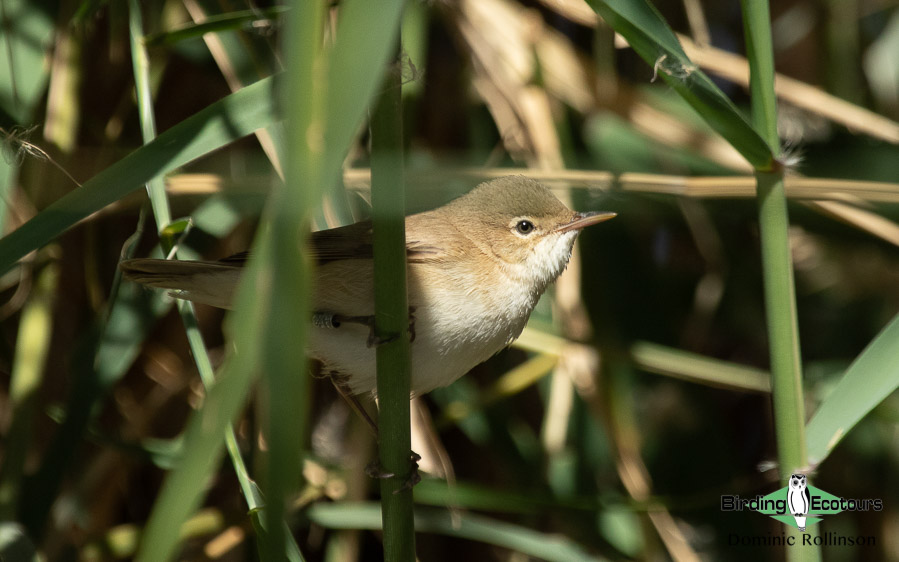
Eurasian Reed Warbler giving good views in their reedbed breeding habitat.
Sedge Warbler, Acrocephalus schoenobaenus
Another sub-Saharan African migrant that is abundant during the UK summer period. Their harsh calls can be heard day and night once they return to their reedbed breeding grounds, sometimes just the smallest patch of reeds is enough to sustain this species which does make use of nearby scrub and hedgerows too.
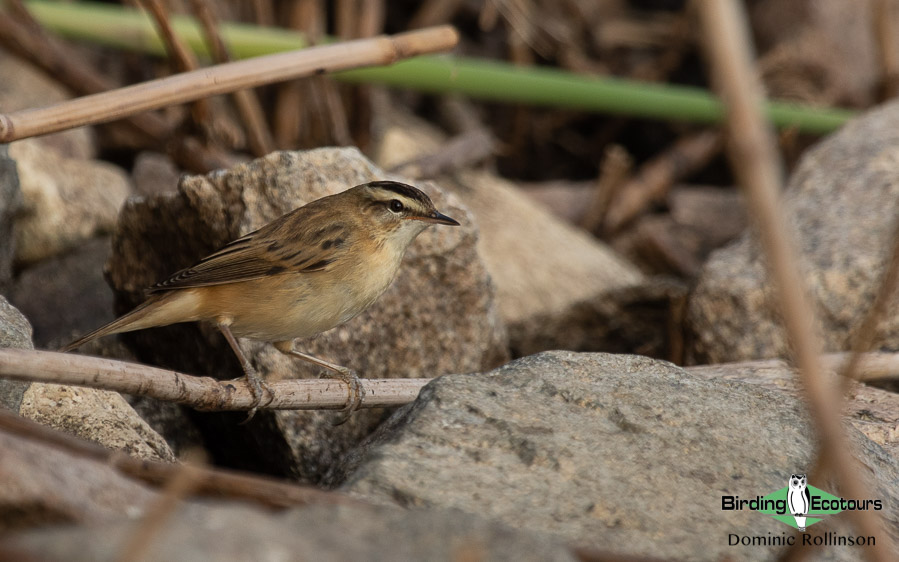
Sedge Warblers sometimes call for long periods right out in the open, giving great views when they do so!
Black-headed Gull, Chroicocephalus ridibundus (UK Amber List: Birds of Conservation Concern 5)
A species with an interesting distribution in the UK. In some areas they are resident year-round, in others they are found in the uplands, and other areas, such as where we take our UK birding tours, they can be found in lowland and particularly in the non-breeding season they can be found utilising coastal reedbeds in England.
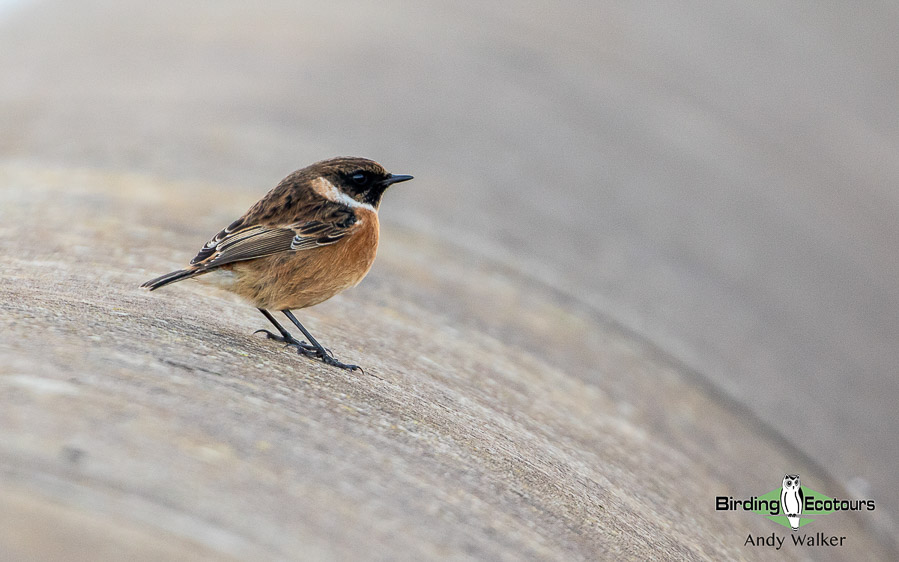
A male European Stonechat is a beautiful sight.
Black-headed Gull, Chroicocephalus ridibundus (UK Amber List: Birds of Conservation Concern 5)
An abundant “small gull” species that is resident in the UK but increases in numbers during the winter months as birds escape the northern ice (e.g. birds move into the country from Iceland and Scandinavia). Along with Mew Gull, known as Common Gull in the UK, often found at coastal and wetland sites but a frequent sight foraging in farmland across the country. They do also occasionally venture into parks and gardens too! Another small dark-headed gull that occurs in the UK is Mediterranean Gull, this species has become very common in some parts of the country over recent years too, but still nowhere near as abundant as the two aforementioned species.
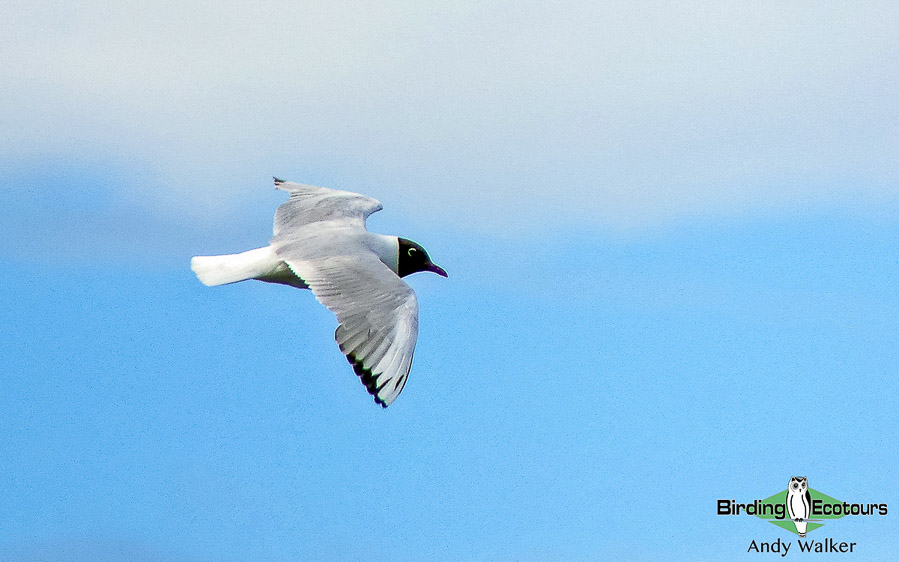
A breeding plumaged Black-headed Gull showing distinctive wing pattern, the noise around their colonies can be deafening!
European Herring Gull, Larus argentatus (UK Red List: Birds of Conservation Concern 5)
Another incredibly common species. Two subspecies occur in the UK (argenteus – which is the smaller of the two subspecies and breeds in the UK and Western Europe and argentatus – which overwinters in the UK, breeds in Scandinavia and the Baltic, and averages larger). There are several other “large white-headed gull” species similar in appearance to European Herring Gull in the UK, but they are far scarcer or even rare such as Yellow-legged Gull and Caspian Gull. Other, more distinctive, and common large gulls, less likely to result in an ID challenge, include Great Black-backed Gull and Lesser Black-backed Gull. It is hard to get away from gulls during the winter in the UK, so they are sure to feature on any of our winter set departure tours or Norfolk day trips! A visit to a gull roost or pre-roost site is a memorable occasion and may feature thousands of individuals and possibly something particularly exciting like an Iceland Gull, Glaucous Gull, or Mediterranean Gull.
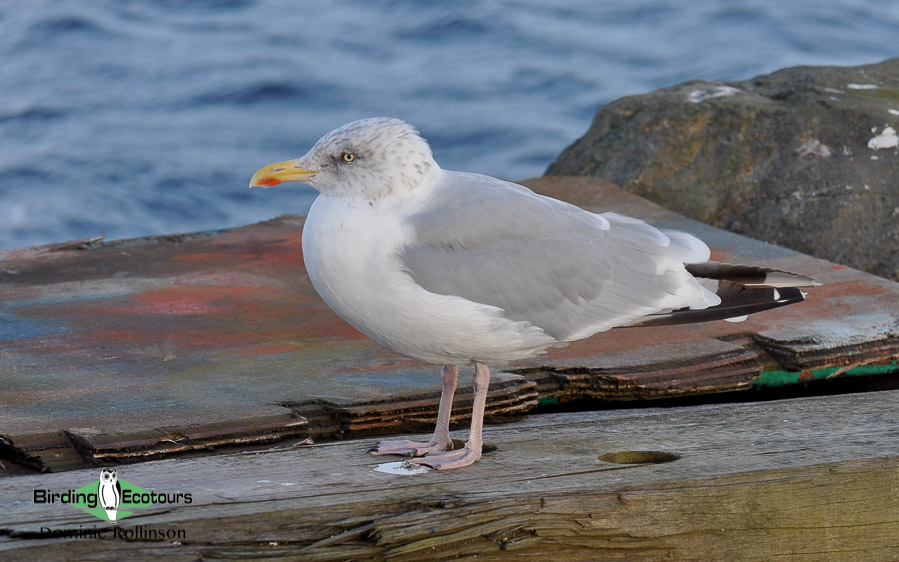
European Herring Gull is one of several “large white-headed gulls” that occur in the UK.
Common Tern, Sterna hirundo (UK Amber List: Birds of Conservation Concern 5)
A long-distance summer breeding visitor to the UK, which overwinter in West Africa (e.g. The Gambia) and South Africa. In the UK they breed colonially or singly at coastal sites as well as at inland lakes, gravel pits, and rivers. Extremely vocal with a powerful bounding flight. The most frequently encountered tern on our UK spring and summer tours, with other species almost as commonly recorded including Sandwich Tern, Little Tern, and Arctic Tern.
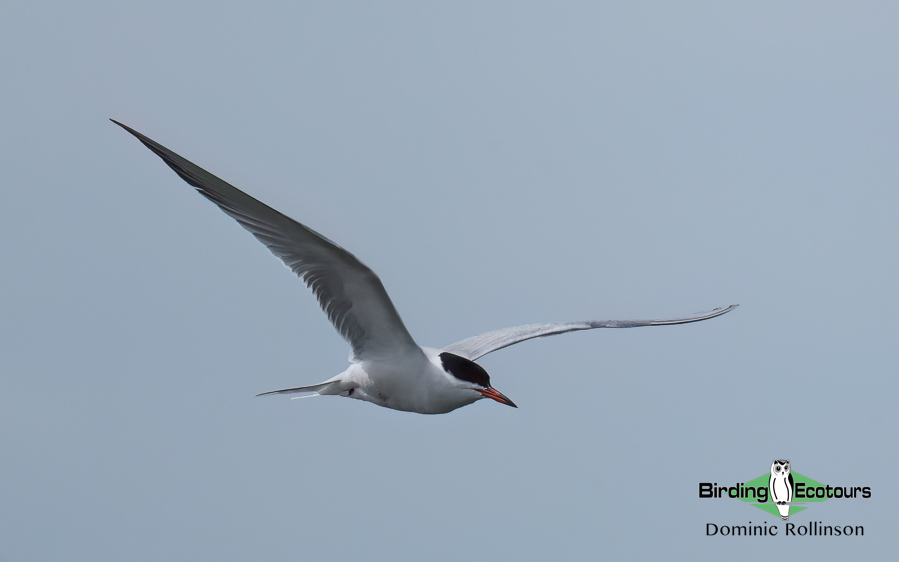
Common Tern is a widespread breeding species in the UK.
Northern Gannet, Morus bassanus (UK Amber List: Birds of Conservation Concern 5)
Breeds colonially along steep rocky coasts at several locations around the British Isles and is frequently seen offshore. During the non-breeding season, they are mainly pelagic (i.e., they spend the winter out at sea away from land). Most likely to be seen on our spring and summer birding tours when fantastic eye-level views can be had at their nesting colonies.
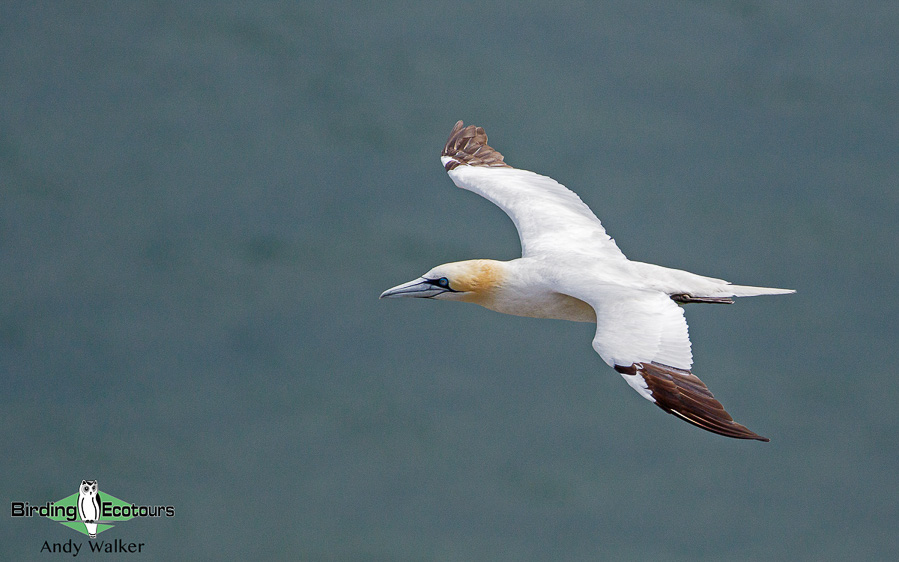
Stunning eye-level flyby views of Northern Gannet are possible at breeding colonies we visit such as at RSPB Bempton Cliffs nature reserve in Yorkshire, England.
European Shag, Phalacrocorax aristotelis (UK Red List: Birds of Conservation Concern 5)
Found around most of the UK coastline where it breeds in loose colonies on coastal cliffs. Smaller and slimmer than the much more abundant and widespread Great Cormorant with which it often associates. It is more strongly associated with the sea and much more likely to be seen there than anywhere else. The best chance to see this species is at breeding colonies or high-tide roosts during the winter.
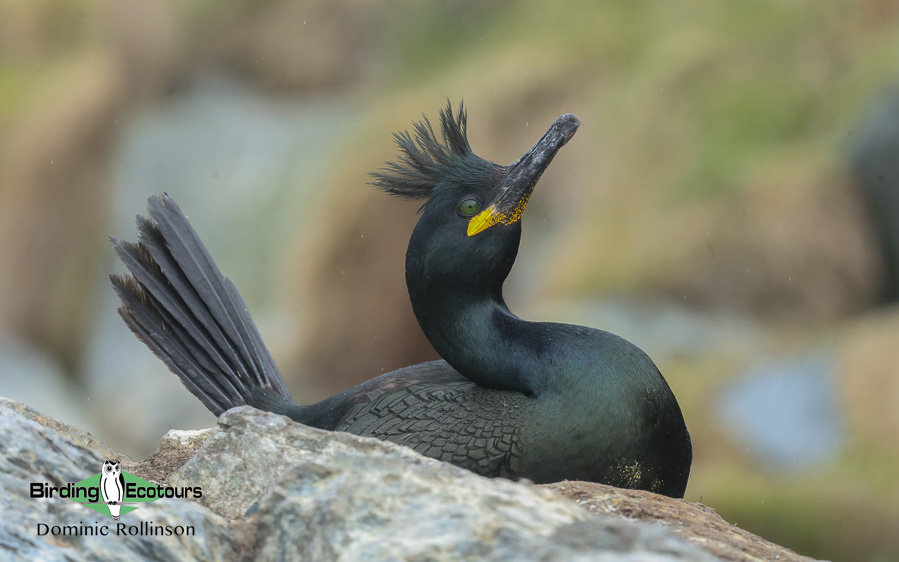
A lone European Shag.
Black-legged Kittiwake, Rissa tridactyla (UK Red List: Birds of Conservation Concern 5)
Common and abundant along most UK coastline but decreasing in numbers fairly rapidly. Rarely seen far away from the coast where it breeds in sometimes huge colonies. They are extremely noisy around these breeding colonies and their commonest call is a quick and nasal “kitt-i-waake”.
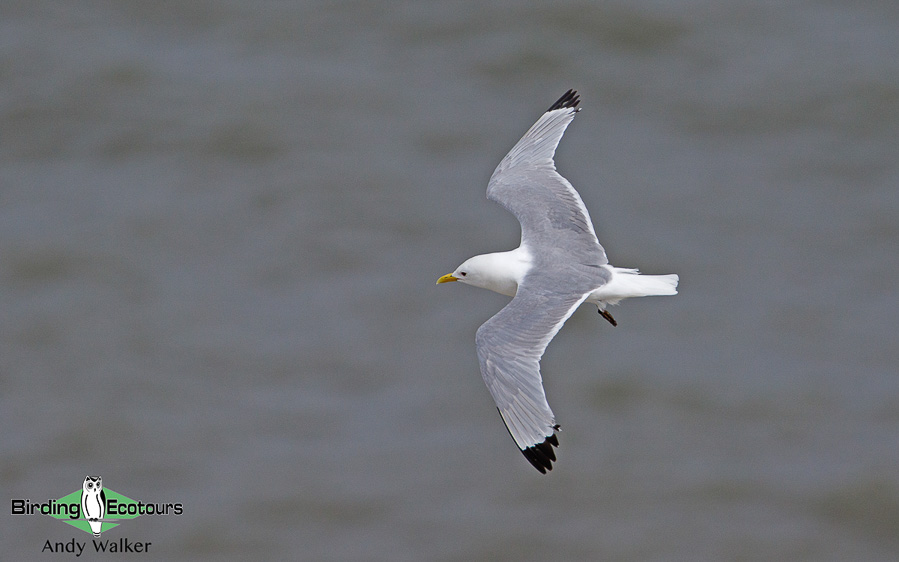
An adult Black-legged Kittiwake at a breeding colony we visit in Yorkshire.
Common Murre (Common Guillemot), Uria aalge (UK Amber List: Birds of Conservation Concern 5)
This is the commonest auk in the UK where it nests on bare, narrow cliff-ledges on steep coastal cliffs, in large colonies (RSPB Bempton Cliffs is a great place for observing these). Interestingly, their eggs are pear-shaped to prevent them from rolling off the cliff! Frequently seen when seawatching off the coast almost anywhere in the UK.
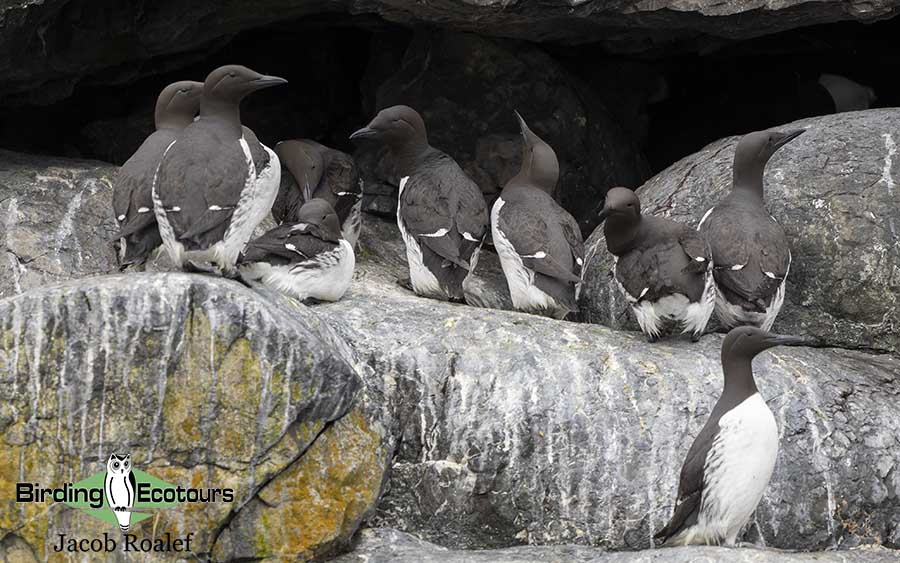
Common Murre breed in large colonies on cliffs.
There are so many other common birds associated with wetland and coastal habitats in the UK and this run down could easily have doubled by including species like Little Egret, Little Grebe, Mute Swan, Greylag Goose, Eurasian Teal, Mallard, Gadwall, Northern Shoveler, Common Pochard, Common Eider, Common Scoter, Northern Fulmar, Eurasian Oystercatcher, Common Ringed Plover, Little Ringed Plover, Bar-tailed Godwit, Sanderling, Red Knot, Dunlin, Grey Plover, Ruff, Manx Shearwater, Razorbill, Lesser Black-backed Gull, Great Black-backed Gull, Mew (Common) Gull, Sandwich Tern, and so many more!
We hope you have found these three blog posts interesting, informative, helpful, and hopefully inspiring. There are so many fantastic common birds in the UK, as shown by over 50 photographed examples in this series, and we are sure you will find great satisfaction in seeing them – especially when in combination with all of the other scarce, rare, localized, and truly special additional species we can see on our tours, such as Scottish Crossbill, Red Grouse, Rock Ptarmigan, Black Grouse, Red-throated Loon (Diver), Whooper Swan, Eurasian Bittern, Common Kingfisher, Hawfinch, Bohemian Waxwing, Golden Eagle, White-tailed Eagle, European Honey Buzzard, Eurasian Hobby, European Turtle Dove, Corn Crake, European Nightjar, Eurasian Stone-curlew, Eurasian Dotterel, European Crested Tit, and Snow Bunting – just to name drop a few of the special ones (there are lots more too!).
The UK has a wonderful tourism infrastructure, ancient and beautiful towns and cities, high quality roads, excellent hotels, quaint bed and breakfast accommodations, great food, and simply world class nature reserves with excellent facilities – great trails, comfortable blinds (hides), high quality interpretation boards, knowledgeable staff, and gift shops and cafes!
Birding is a big part of British culture and has been for many years. There are great news services for finding out about rare and scare birds (e.g. Birdguides Rare Bird Alert, and Surfbirds), and some of the oldest and most highly respected bird-oriented organizations in the world exist, such as the Royal Society for the Protection of Birds (RSPB) – BirdLife International’s UK partner – and the British Trust for Ornithology (BTO). Each region has their own bird club or society, and birdwatching is a serious hobby for many millions of people.
We know that you will enjoy our set departure tours in the UK as well as our Norfolk birding day trips and we really look forward to showing you around this great birding country.
Seen these birds at home? Let Birding Ecotours take you further
Whether it’s enjoying close-up views of familiar countryside species or expanding your list with birds from further afield, we’ve got a range of birding tours to suit every season and interest.
Explore our UK and European tours
Browse our worldwide birding adventures
If you’d like any advice on which tour would best suit your needs, or if you have any questions, feel free to email us at [email protected], we’re happy to help!
Click for Common Garden Birds of the UK
Click for Common Farmland and Woodland Birds of the UK
